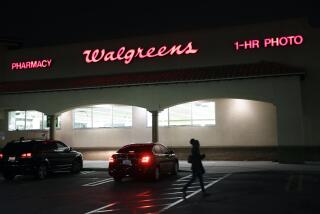Safeway Sale May Start Food Fight
When the Safeway signs eventually come down from the stores purchased Thursday by Vons Cos., a new round of competitive frenzy among Southern California supermarket chains is expected.
For Southland consumers, that’s good news because they will probably benefit from lower prices.
The long-term outlook for prices, however, is less certain. Safeway’s departure from the nation’s most competitive food market solidifies Vons’ position as the Southland’s largest supermarket chain and eliminates the fifth-biggest.
Nevertheless, at least a dozen other chains, including Ralphs, Lucky, Alpha Beta, Stater Bros., Boys, Hughes and Albertson’s, will be attempting to lure Safeway’s old customers.
“Any time a major chain has changed hands or changed directions in Southern California,” explained Jack Brown, president of the Stater Bros. chain, “it always spurs extra-competitive activity in the marketplace.
“To that degree, customers will benefit on a temporary basis as the surviving chains will vie for the loyalty of the Safeway customer. Certainly Vons, in acquiring the stores, will work hard to maintain those customers, but this is the moment when most chains will move.”
Safeway’s exit is the latest in a string of store consolidations that have characterized the industry since 1978. In the last nine years, Fazio’s, FedMart, Market Basket, Dale’s, Thriftimart, Jewel T. Discount and Smith’s Food King have all abandoned Southern California.
Most recently, Gemco closed its 80 stores late last year, resulting in $1 billion in food sales up for grabs by the various chains. Competition for those sales and in general have precipitated heavy price promotion and double coupon offers throughout the industry.
But supermarket operators are having to indulge in such costly promotions at a time when food prices in the area are rising only 2%.
After discounting for inflation, sales industrywide have been running flat on a comparable store basis from a year ago, according to supermarkets executives.
No one was predicting that things would get easier in the supermarket business as a result of the Safeway deal, and few seemed surprised by the latest name changing in the Southern California supermarket derby.
Details Sketchy
Steven Koff, president of the Southern California Grocers Assn., said, “If you at look past history, there has always been this kind of activity. If you go back to articles of 1920s and 1930s, this kind of thing always took place. People thought the independents woul1679844457innovative independence and creative change here.”
Lucky Stores’ chairman and chief executive officer, John M. Lillie, said his chain “will need to watch what (Vons) might do and be ready to respond,” but he declined to be more specific.
A Ralphs spokesman said it was inappropriate to comment until “we know what is happening.”
Details on Vons’ plans for the Safeway stores are sketchy, but the acquisition would nearly double the number of Vons’ current 193 stores, which generated $3 billion in sales in 1986.
Safeway’s Southern California operations had sales of $1.6 billion in 1986, the company said.
One thing is sure, Vons’ competitors will be watching the El Monte company closely to see how well it absorbs, finances and manages the new Safeway stores.
Vons incurred massive debt in a management-led buyout valued at about $750 million last January. In July, Vons became a publicly traded company through a merger with a Detroit supermarket chain, Allied Supermarkets.
The chain has had lackluster earnings, reporting net income of $100,000 for the third quarter ended Oct. 4, up from a $7.1 million loss the year before. For the nine months, Vons reported net income of $4.4 million on sales of $2.4 billion, compared to income of $33.7 million on $2.2 billion in sales the year before. As of Oct. 4, Vons’ debt totaled $558.9 million.
No Dominant Firm
Southland chains are well-versed in tackling the competition in a market that generates more than $20 billion annually in food sales. However, no one chain has ever dominated the market.
Recent surveys by the Los Angeles Times Marketing Research Department showed four chains--Vons, Ralphs, Lucky and Alpha Beta--together accounted for 58.3% of all shopper traffic in the first six months of this year. Safeway ranked in fifth place with 6.1% of the shopper traffic, while Vons was No. 1 with 17.4%.
Industry insiders says that privately held Safeway, which does not disclose or break out regional earnings, had been profitable with its Southern California stores but they say the sale of the group was of more value to Safeway’s owners than to continue to operate them.
Brown describes the Safeway Southern California business as a “a very, very fine division. The facts are, however, that you have a parent company KKR who are investors and their goals are somewhat different than individuals who have devoted careers to the food business, whose strength is in building an operating company. I’m not faulting them or anyone, but the goals are different.”
Times Staff Writer Keith Bradsher contributed to this story. CHAINS THAT HAVE QUIT SOUTHLAND MARKET April, 1978 Fazio’s, a Cleveland-based chain, gives up its expensive effort to enter the Southern California market after failing to gain significant market share and sells its 46 stores to Albertson’s Inc., Boise, Ida.
June, 1982 San Diego-based FedMart, a chain of discount department and grocery stores, decides to close all 46 of its outlets because of losses. Ralphs buys 15, and the rest are sold to non-grocery chains.
June, 1982 Cincinnati-based Kroger Co., citing intense competition and the fact that it has too few stores to compete with bigger chains, decides to sell or close all 66 of its Market Basket stores in Southern California. Ralphs, Boys, Hughes and Vons purchase many of the stores.
March, 1984 Los Angeles-based Thriftimart Inc., saying it has too few stores and those it does have are too small to compete with newer “warehouse” stores, decides to sell or close all 40 of its outlets. Many are purchased by Safeway, Vons, Lucky, Boys and Dale’s.
March, 1984 Dale’s Food Marts, a family-owned chain of 11 stores based in the San Fernando Valley, decides to sell out to Lucky.
March, 1984 Chicago-based Jewel Cos. gives up on its highly touted but money-losing Jewel T Discount chain in Southern California, closing all 21 stores.
September, 1984 Salt Lake City-based Smith Management Corp. decides to sell all 34 Smith’s Food King stores in Southern California to Lucky.
July, 1986 Vons purchases the 10-store Pantry supermarket chain, which was based in Pasadena, from Cullum Cos. of Dallas. Half of those stores are now Vons and the remainder operate under the Pantry name.
October, 1986 Gemco closes the grocery departments in its 80 stores, which are converted to Target discount stores by Dayton Hudson of Minneapolis. Lucky Stores of Dublin, Calif., sacrifices Gemco as part of a restructuring to remain independent. August, 1987 The eight-store Foods Co. chain is purchased by Los Angeles-based Boys Markets, which has been operating 46 stores in predominantly Latino, black and Asian neighborhoods.
HIGHLIGHTS OF DEAL * Safeway leaves Southern California and sells to Vons its 172 stores and its warehouses, dairies and bakeries.
* Vons will close some Safeway and Vons stores, but won’t say which. All remaining Safeway stores will become Vons supermarkets.
* Vons will pay $325 million in cash and give 30% of its stock to Safeway. The deal is to be completed by mid-1988.
More to Read
Inside the business of entertainment
The Wide Shot brings you news, analysis and insights on everything from streaming wars to production — and what it all means for the future.
You may occasionally receive promotional content from the Los Angeles Times.










